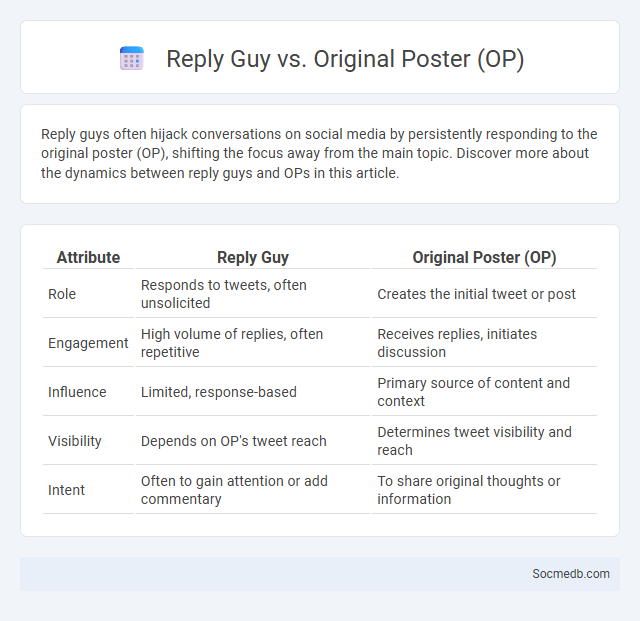
Photo illustration: Reply guy vs original poster (OP)
Reply guys often hijack conversations on social media by persistently responding to the original poster (OP), shifting the focus away from the main topic. Discover more about the dynamics between reply guys and OPs in this article.
Table of Comparison
| Attribute | Reply Guy | Original Poster (OP) |
|---|---|---|
| Role | Responds to tweets, often unsolicited | Creates the initial tweet or post |
| Engagement | High volume of replies, often repetitive | Receives replies, initiates discussion |
| Influence | Limited, response-based | Primary source of content and context |
| Visibility | Depends on OP's tweet reach | Determines tweet visibility and reach |
| Intent | Often to gain attention or add commentary | To share original thoughts or information |
Introduction to Reply Guys and Original Posters (OP)
Reply Guys are individuals who frequently respond to posts, often seeking attention or validation, while Original Posters (OP) are the users who create the initial content or thread. Understanding the dynamic between OP and Reply Guys is crucial for analyzing engagement patterns and discourse on platforms like Twitter, Reddit, and Facebook. This interaction reveals insights into community behavior, influence, and the evolution of online conversations.
Defining the Reply Guy Phenomenon
The Reply Guy phenomenon involves individuals who frequently respond to social media posts, often unsolicited, in a way that seeks attention or validation. These interactions can disrupt online conversations by diverting focus from the original post and frustrating other users. Understanding this behavior can help you navigate social media dynamics more effectively and maintain a positive digital environment.
Who is the Original Poster (OP)?
The Original Poster (OP) is the individual who creates and shares the initial content or post on a social media platform, serving as the starting point for discussions and interactions. Identifying the OP is crucial for understanding context, intent, and the flow of conversation within threads on platforms like Reddit, Twitter, and Facebook. Tracking the OP's contributions helps in analyzing user behavior, engagement patterns, and content origin in social media analytics.
Typical Interactions: Reply Guy vs OP
In social media discussions, the typical interaction between a "Reply Guy" and the Original Poster (OP) often involves the Reply Guy persistently responding to the OP's posts, sometimes derailing the conversation or attempting to assert authority. The Reply Guy frequently overlooks nuances in the OP's message, leading to misunderstandings or repetitive comments that dilute the original intent. Your awareness of these dynamics can help maintain more meaningful and focused online conversations.
Behavioral Patterns of Reply Guys
Reply guys often exhibit persistent engagement patterns on social media, repeatedly commenting on posts to gain attention or validation. Their responses tend to prioritize quantity over quality, frequently disregarding the original content's context. Understanding these behavioral patterns can help you manage interactions more effectively and maintain a positive online environment.
Common OP Reactions to Reply Guys
Reply guys often exhibit repetitive comments and unsolicited advice in social media threads, which can clutter conversations and frustrate original posters. Your interaction with these users might feel overwhelming due to their persistent engagement and tendency to derail discussions from the main topic. Understanding common reply guy behaviors, such as over-explaining or unsolicited compliments, helps maintain a productive social media environment.
Online Dynamics: Power and Influence
Online dynamics shape the power and influence wielded across social media platforms, where algorithms amplify certain voices and content based on engagement metrics. Your digital presence is affected by network structures, including follower interactions and the spread of information through social graphs, making strategic communication essential for impact. Understanding these mechanisms allows you to navigate influence patterns and maximize reach effectively.
Psychological Motivations Behind Replying
Individuals often reply on social media driven by psychological motivations such as the need for social validation, the desire to express identity, and the pursuit of emotional connection. Positive reinforcement through likes, comments, and shares fosters a sense of belonging and self-worth, while engaging in conversations allows users to affirm personal beliefs and gain social support. These interactions activate reward pathways in the brain, reinforcing the behavior and motivating continued participation.
Community Impact: Evolution of Thread Discussions
Thread discussions on social media have transformed community engagement by fostering deeper, more meaningful interactions and enabling users to share diverse perspectives efficiently. Your participation in evolving thread formats enhances the collective knowledge and strengthens social bonds within digital communities. These dynamic conversations amplify voices, promote inclusivity, and drive positive social change across online platforms.
Strategies for Managing Reply Guy Interactions
Establish clear boundaries by setting response limits and using platform-specific tools such as muting, blocking, or restricting to control Reply Guy interactions effectively. Craft concise, firm replies that avoid encouraging further unsolicited comments while redirecting conversations to relevant topics or community guidelines. Consistently applying these strategies helps maintain a positive social media environment and reduces the impact of persistent or off-topic responders.
 socmedb.com
socmedb.com